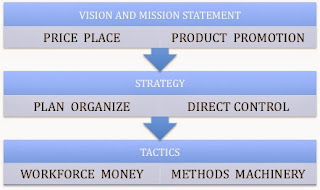VISION AND MISSION SHOULD DRIVE STRATEGY

The chart below demonstrates the approach for developing a successful marketing strategy. The graphic suggests that a vision and mission should drive the price, place product and promotion marketing components and that once these 4 Ps are identified a strategy can be developed. It is interesting to ask which of the 4 P’s is most important. To determine value of each of the four Ps requires a vision and mission statement that clearly defines the nature of a business, the market segment to be served and an idea of what success looks like. For my classes at the University of Houston’s Bauer College of Business I have used the example of an individual with a pressure washer and limited funds wishing to enter into the maintenance business and grow to be a major player in home and commercial maintenance. This individual might create a mission statement that as follows: 1) To make available quality exterior maintenance service to home and busin...